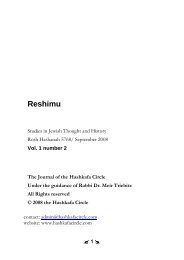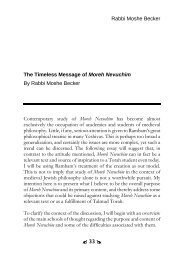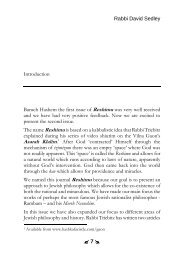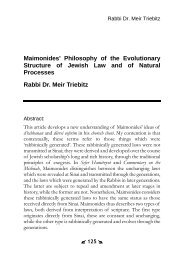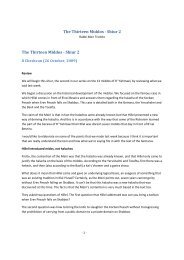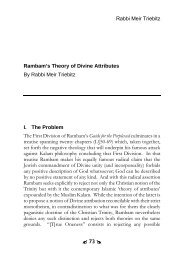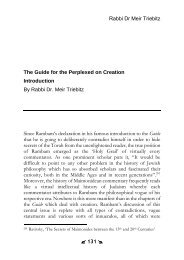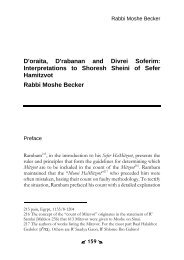Reshimu_3_journal_no.. - Hashkafa Circle
Reshimu_3_journal_no.. - Hashkafa Circle
Reshimu_3_journal_no.. - Hashkafa Circle
Create successful ePaper yourself
Turn your PDF publications into a flip-book with our unique Google optimized e-Paper software.
Rabbi Moshe Becker<br />
an addition. 72 The strong stance that Halevy takes is intended to<br />
uphold the integrity of the Talmud’s origins, in the face of opinions<br />
such as those expressed by Weiss, that the Talmud was in fact never<br />
sealed, but rather left fluid and open to the scholars of every<br />
generation. As a result, many additions and editions were made, be<br />
they mistaken or willful, and there is <strong>no</strong> inherent purity or authority<br />
to the work of the Amoraim and Savoraim 73 .<br />
Refuting such positions actually seems to have been one of the<br />
primary goals of Dorot HaRishonim, and strong rhetoric is quite<br />
prominent in Halevy’s treatment of the redaction of the Talmud.<br />
Halevy felt that the approaches of Graetz and others challenged the<br />
integrity of the “Mesorah” – the continuous tradition of the Torah<br />
that has been handed down from generation to generation. To<br />
address this he wrote his own record of the Jewish history from a<br />
traditionalist point of view.<br />
Specifically regarding the redaction of the Talmud, the conclusions<br />
reached by Graetz and others conjure up the image of a lone, almost<br />
renegade scholar producing the Talmud with little popular support<br />
and virtually <strong>no</strong> authority, formal or otherwise. Obviously the result<br />
of such work can<strong>no</strong>t be seen as authoritative in any way, let alone the<br />
untouchable basis of all contemporary Jewish life and scholarship.<br />
Halevy also quotes the views of S.Y. Rappaport, who writes that the<br />
Talmud was created to address the emergency situation that the<br />
community found itself in due to persecution, as opposed to the<br />
picture presented by Halevy of a premeditated, planned and<br />
concerted project, which was the product of, and made possible by,<br />
peaceful times for the Jewish community in Babylonia. Halevy saw<br />
in the words of these historians an attempt to undermine the<br />
72 Although it’s hard to ig<strong>no</strong>re the additional possible reading: that R’ Ashi alone<br />
was responsible for compiling the Talmud, without the various stages and layers<br />
suggested by Halevy.<br />
73 Quoted by Halevy in III, p. 140.<br />
33



